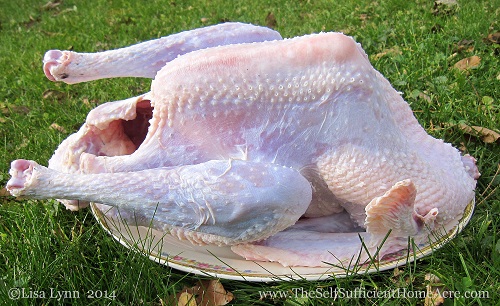
See also How to Butcher a Chicken
How To Skin a Chicken, or Any Other Poultry
I recently shared an article, Should You Skin or Pluck Your Home Butchered Poultry, where I shared my thoughts on the pros and cons of each of these methods of processing. You may choose to pluck your poultry and save the skin. I have instructions for plucking in my butchering tutorial. When I have one or two birds to process, or when I have to perform an unplanned butcher session (when one of my flock has been injured, for example) I normally skin them.

I’ve had a number of people ask me how to skin a chicken. Since I’ve had a good bit of practice skinning small animals, such as rabbits and poultry, I thought it might be helpful for my readers to have a step by step tutorial.
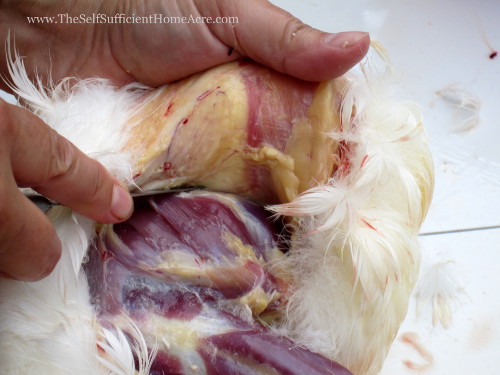
Start With the Neck
The best advice I can give to anyone preparing to skin a chicken is to start at the neck and work your way down the body. The skin around the neck, breast, and abdomen is rather loosely attached to the carcass and will come off fairly easily. The skin on the back is a bit more tightly attached, and the skin on the wings, tail, and legs is the most difficult to remove.
Work Toward the Back
Assuming that you are not trying to save the skin in one piece for any reason, you can just rip it away from the body in the loose areas, and use a sharp knife to cut through the membrane between the skin and meat on the back, legs, and wings. I find the wings to be the most difficult, because the wing feathers are well attached below the surface of the skin.

Rather than take the time to remove the skin and feathers from the wing tips, I sever the ligaments of the joint and remove the end of the wing. There is very little meat there and I would rather feed this bit back to my chickens than mess around with skinning it.
As you work down the body, continue pulling the skin back and use the knife to separate the skin from the meat where necessary. I usually pull the skin off in sections.

Pull the skin on the legs down toward the feet and use the knife to free it if you need to. When you have the skin pulled down to the scaly part of the leg at the hock joint, you can stop pulling the skin and just remove it along with the lower leg and foot. You’ll do this by separating the joint. Cut through the ligaments that hold the joint together. Avoid cutting the bone and dulling your knife. You just want to sever the connective tissue and pull back on the ‘knee’ as you cut, to pull the joint apart. This allows you to remove the lower leg and skin all in one piece.

Careful Not to Spill Your Guts!
When you get to the skin around the back end of your chicken, you will need to be careful not to cut through the skin and abdominal wall into the intestines. I do this by pulling the skin down to the area around the vent, then I cut into the abdominal wall. To do this without cutting into the intestines, lay the bird on its back. Lift up on the skin and abdomen with one hand and insert the knife through the thin layer of tissue that holds the intestines in. The innards will be settled down below the rib cage level enough that you should be able to do this without poking into them with your knife. Now you will continue pulling up on the skin as you work the knife through the thin muscle tissue back to the vent area.

The skin around the tail is tough to remove, since the feathers are embedded in the fatty tissue of the tail. I cut the whole tail off when I skin a bird. It works best for me if I insert the knife between the vent (on the inside of the bird. Use your index finger on your other hand to hold the rectum out of the way as you do this) and the tail, with the sharp side of the knife facing the tail. Cut into the tail and sever the spinal cord to remove the tail.
Pull the intestines, tail, and skin out away from the bird and put in your offal container. All of this goes to my chicken flock. They aren’t vegetarians by nature!

Wash your chicken thoroughly. You will find that little bits of feather fluff will stick to the meat and need to be cleaned off. If you skin your chickens and plan to freeze them, I recommend using a vacuum seal system to prevent freezer burn on the meat. With the skin on, the meat is protected from freezer damage for a longer period of time. When you cook the chickens, keep in mind that the meat will dry out faster without the skin to hold the moisture in!
Do your skin your poultry or pluck them? Or does it depend on the situation?

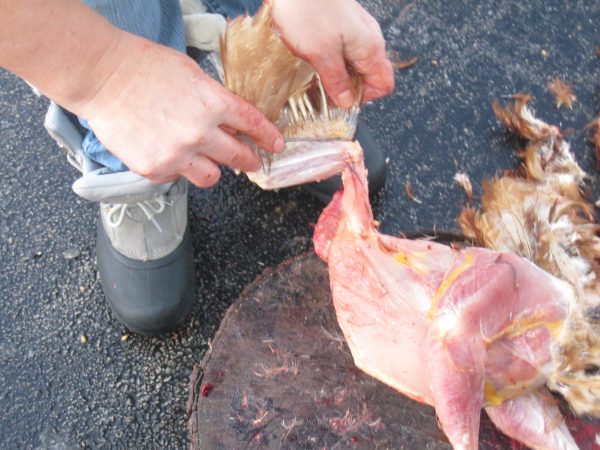
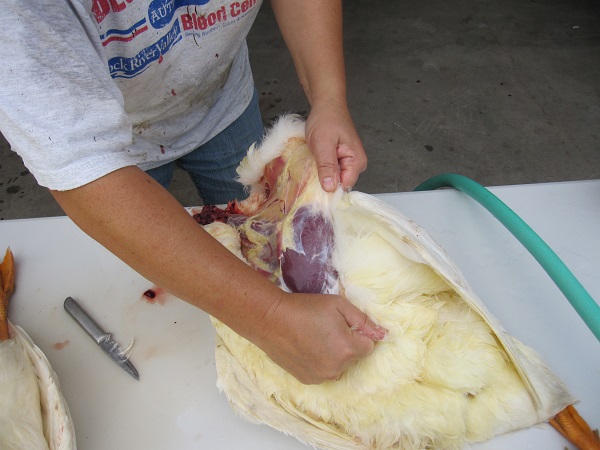

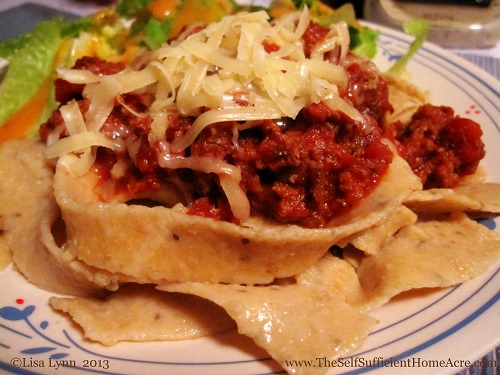
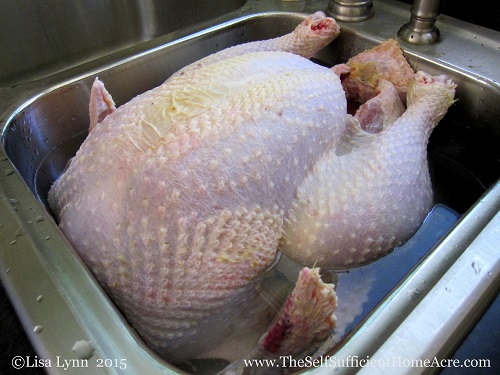
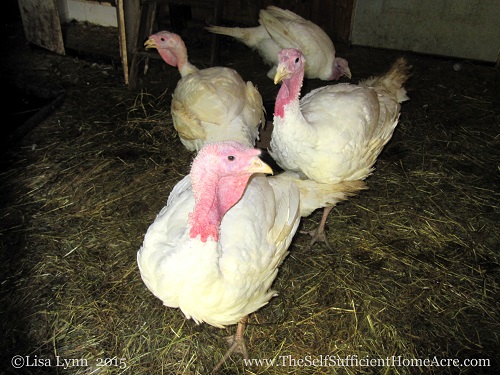

My friend said they cut the head off but if you use a slip knot, the vertebrate will hold the chicken… She used to skin them that way.
I haven’t tried that!
We usually hang the chicken up by its feet after we kill it. Then we put a slit into each leg and then pull the skin with feathers on it down. Easiest way to skin it.
Hi Christie,
Thanks for sharing your experience here!
I usually pluck my nest birds, I use a plucker I built, greatest way to pluck chickens ever! Occasionally I do skin them if just using for broth like the 6 roosters I got with my 75 sex linked pullets. I cut out the breasts then threw them in the pot to can broth. I don’t care for baked or grilled chicken without skin, just makes them dry. I remember taking chickens to a BBQ, and to my dismay they skinned them all, as far as I was concerned they were inedible, you could barely choke them down with lots of water. Even if you don’t eat the skin it protects the meat from drying out and forming a crust of dried meat on the outside of each piece.
Thanks for the ideas. The first time we processed we did a few of each to see what we liked. I agree that there are times that call for both. It depends on what I have planned for the meat. I like having options. If I’m doing a slow cooker or pressure canner recipe I prefer them skinned, but if I’m roasting I prefer plucked.
Hi Jennifer,
I agree…I like them better skinned for the crock pot too. And the skin really does help keep a roasted bird juicier!
I’ve been wondering if you can skin rather than pluck. We decided to keep a few backyard chickens for eggs. They were young when we got them and one of our ladies turned out to be a rooster. He is the meanest bird ever. It’s hard to feed, water, collect eggs or clean out their pen. We enjoyed letting them free range until he started attacking everyone that he saw as a threat. Which happens to be everyone! My grandkids love the chickens but I can’t let them get close enough to the pen to hand feed them like they did when they free ranged. They were so much fun until the rooster got so mean. I’ve had enough bruises from his attacks I know I can butcher him myself. I helped butcher chickens years ago but was dreading the scalding and plucking.
Next time he goes for my hands shins or ankles this rooster is stew!!!
I’m sorry to hear he’s been such a pain, Tina. ;( I’ve never had a mean rooster, but recently butchered a tom turkey that started to attack me…and boy, he was scary! So I know what you mean and I completely agree, that rooster should be stewed! You might want to try pressure canning the meat if you can, it will be much more tender. Good luck!
Exactly what I’ve been looking for. I am planning to butcher a batch of chickens in a couple of months and had been planning to skin them prior to processing them in my pressure canner. I hate plucking and have experience in skinning other animals, so I’m hoping I will find this route easier for me 🙂
Thanks so much for the help!
Erin
https://yellowbirchhobbyfarm.blogspot.com
Hi Erin,
Happy to share info! If you are killing by bleeding them out, you might want to try Donna’s suggestion above…she hangs the chickens by the necks to skin them. I think it might be easier than setting them on a table. I remove the heads, which makes it kinda hard to hang them that way. 🙂
Best wishes! Let me know how it goes.
That was a helper post.
Happy to help, Margie!
I also skin my chickens and you are correct it is something that you just get better and better at the more it is done. I have what I call a processing station. The killing station is a large saw horse approximately 8 foot at top height. The front is where I hang my killing cones (we made our own) and the buckets underneath to catch the blood, then we use the side of the saw horse to hang the chicken by the neck in a noose. This allows us to use both hands and a scalpel to free the skin from the chicken.
Hi Donna,
Sounds like a great set up! I tried hanging my chickens to skin them, but made the mistake of hanging them by the feet. I’ll have to try hanging them by the head. Which means I won’t be able to chop the heads off! Hmmm, what a dilemma. 🙂
Thanks for sharing how you do it!